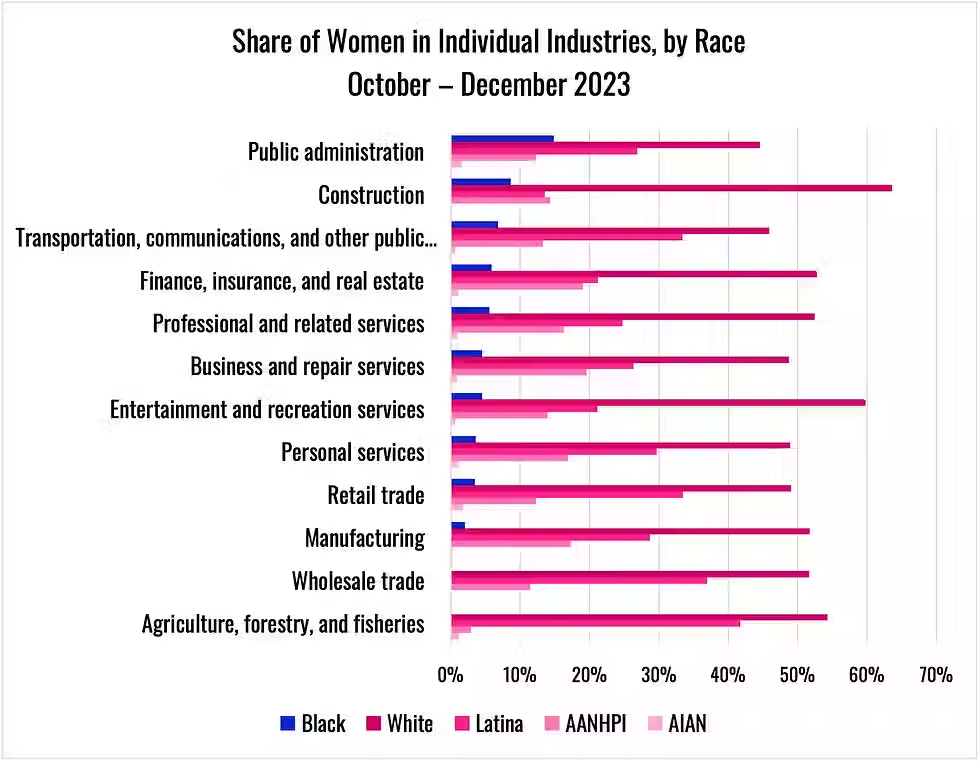CA Black Women's Jobs Report: Q4 2023
- Feb 5, 2024
- 3 min read
By Raksha Kopparam, Senior Research Associate
California Black Women’s Collective Empowerment Institute

Last month, the U.S. Bureau of Labor Statistics released the labor market data of the fourth quarter of 2023. Below are five graphs that analyze the trends in California’s Black women employment statistics.
Labor Force Participation Rate

The 4th quarter of 2023 shows decline in Black women's labor force participation rate, with an approximate decrease of 3 percentage points between October and December. While Black women’s LFPR is still higher than the LFPR of women of other races, this decline indicates that labor market strength has been faltering.
Several economic factors contribute to the fluctuations and potential decline in Black women's labor force participation rates. Structural issues such as persistent wage gaps, limited access to quality education and job training programs, along with systemic barriers to career advancement disproportionately affect Black women. The intersectionality of race and gender compounds these challenges, resulting in heightened vulnerability to economic downturns and job market fluctuations. Additionally, the lack of affordable childcare options and family-friendly workplace policies presents significant barriers for Black women seeking to balance work and caregiving responsibilities. This potentially leads to fluctuations in labor force participation rates.
Addressing these economic disparities requires comprehensive policy interventions aimed at dismantling systemic barriers, promoting equitable access to employment opportunities, and implementing supportive measures that enable Black women to fully engage in the labor force and achieve economic security.
Employment-to-Population Ratio

Examining the employment-to-population ratio of Black women from October to December 2023, there is a noticeable decline from 56.0% in October to 54.9% in December. This downward trend suggests a weakening in the proportion of Black women who are employed relative to the population of Black women. Seasonal hiring and fluctuations in labor market activity can indeed contribute to the decline in Black women’s EPOP. During Q4 of 2023, various industries experienced shifts in demand due to seasonal factors such as holiday shopping, tourism, and weather-related needs. However, these seasonal opportunities may not always align with the familial obligations of Black women, leading to limited job options and reduced employment prospects. Seasonal hiring doesn’t always ensure the benefits of full-time work, such as healthcare and caregiving benefits, which create further barriers for Black women seeking sustainable employment. Moreover, the heightened competition for seasonal positions, coupled with the prevalence of structural inequalities and discriminatory practices in hiring, can further marginalize Black women in the labor market.
Moreover, many companies adjust their staffing levels and budgets towards the end of the year, which may decrease job openings and hiring activity overall. This impacts employment opportunities for Black women, who are already competing in a workforce plagued with systemic biases and barriers. Consequently, the combination of seasonal hiring patterns and broader fluctuations in labor market dynamics during the months of October through December can attributed to the decline in the employment-to-population ratio among Black women.
Unemployment Rate

December brought about the lowest unemployment rate for Black women in 2023 at 3.9 percent. While seasonal employment in the fourth quarter could have contributed to the decrease in EPOP, it could also contribute to increased employment opportunities in certain industries, particularly in sectors such as retail, hospitality, and customer service. As businesses prepare for the holiday season and consumer demand rises, Black women may find more employment opportunities available to them, thus reducing the unemployment rate. However, it is important to note that most of these seasonal jobs will end around February, therefore, the decline in unemployment caused by seasonal work will not remain long-term. The last quarter tends to result in significant volatility in the labor market, so it is important to look at economic factors across the year as opposed to one quarter.
Industry


The industries with the largest share of Black women workers had both net gains and losses in the number of new jobs in Q4 2023. Transportation and professional services, which have a high share of Black women workers, experienced significant net losses in new jobs this quarter, while the government sector experienced strong net gains. Overall, the trends indicate that across all industries, more needs to be done to increase Black women's employment. Programs that help Black women build the skill sets they need to thrive in all industries will not only help improve Black women's employment trajectory but will also improve the economy as a whole.
Overall, the 4th quarter of 2023 was not as strong for California’s Black Women workers as prior quarters. With economic hurdles such as mass layoffs in industries like financial services and technology or the seasonal volatility of the quarter, Black women still experienced record-low unemployment and minimal declines in labor force participation and employment-to-population. These economic trends indicate that when there is effective public investment in the economy, as seen earlier in the year, Black women thrive alongside the entire workforce and can withstand the volatility of seasonal changes in the labor market.



Comments